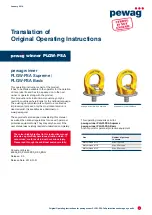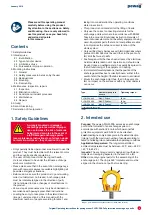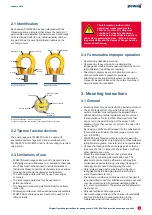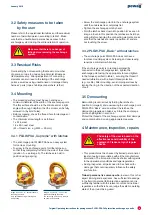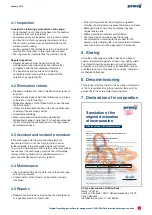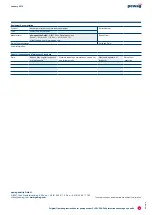
3
Original Operating Instructions for pewag winner PLGW-PSA Fall protection anchorage eye bolts
January 2019
2.1 Identification
Each pewag PLGW-PSA has been stamped with the
thread size and a pictogram that shows the number of
permissible users allowed. Furthermore each anchorage
point is stamped with its own individual serial number.
Image 2 shows the exact identification details on the
anchorage point.
The information provided in this
operational manual assumes the
absence of particularly dangerous
conditions. Particularly dangerous
conditions include offshore operations
and nuclear contaminated areas. In these instances,
the permissibility and the degree of danger must be
discussed with pewag.
2.4 Foreseeable improper operation
• Operation by unskilled personnel.
• Operation by those who do not understand the
language used within this manual and therefore do not
fully understand what they are reading.
• Attaching to objects where no instruction manual or
strength verification is present or available.
• Attaching connecting elements where no instruction
manual or inspection based on the norms mentioned
herein is present or available.
3. Mounting Instructions
3.1 General
• Mounting must only be carried out by trained personnel.
• The anchorage system onto which the anchorage
point is mounted, must withstand the applied forces
without deforming (safety regulation) and must meet
the regulations of norm EN 795. Maximum force that
can occur in the axial direction of the screw: 14kN.
Maximum force that can occur normal to the axis of the
screw: 14kN.
By design no shifts are introduced into the substructure.
(This data are valid when the anchorage point is used
acc. to EN 795).
• PLGW-PSA anchorage points are to be screwed into
steel or cast steel parts only. Applying to other materials
(as light metals, plastic, concrete, etc.) is not permissible
• Choose the location of the anchorage point so that in
the event of a fall, no impact on the surface or with any
other obstacle can occur.
• Mount the anchorage point so that you are able
to reach the connecting elements with ease. The
attachment points must be affixed in such way that
no dangerous points (bruising, shearing, trapping or
bumping) are produced endangering the user.
• Only original pewag parts are allowed to be used –
recognisable by the stamping (batch identification
mark, thread diameter etc.).
• The delivery condition is not allowed to be changed. It
is not permitted to perform additional welding, heat and/
or surface treatments with material-damaging effects
(e.g. electro galvanised). The screws are not allowed to
be shortened.
• Only use faultless anchorage points.
• Used anchorage points must be checked for suitability
and function before mounting according to the
maintenance instructions (section 4.1. and 4.2.).
Image 2: Identification on Sleeve and Screw.
Component description and location of identification details on product.
Image 2: Front View
Image 2: Back View
Product family
Manufacturer
Ring
Latch
Serial
Number
Screw
Sleeve
CE-Identification
Batch
Max. Permissible
Persons
Thread Size
Product Name
Note User
Information
Norm Declaration
2.2 Types of anchor devices
The anchorage point PLGW-PSA can be used with
anchorage systems Type A and B in accordance with
EN 795-2012; DIN CEN/TS 16415 (for securing more than
one person).
2.3 Limitations of use
• PLGW-PSA anchorage points are not to be used in areas
with highly corrosive influences (e.g. sewage or chemicals
etc.). They must not be exposed to acids and alkalis or
their fumes. Please consult our technical service on advice
for using the products in aggressive environments.
• The anchorage points must not be used over edges
or corners.
• The anchorage points must not be exposed to
permanent stress.
• The hanged-in connecting elements must move freely
in the ring.
• Anchorage points must not be used permanently outdoors
• PLGW-PSA anchorage points must not be used for the
lifting of loads.

